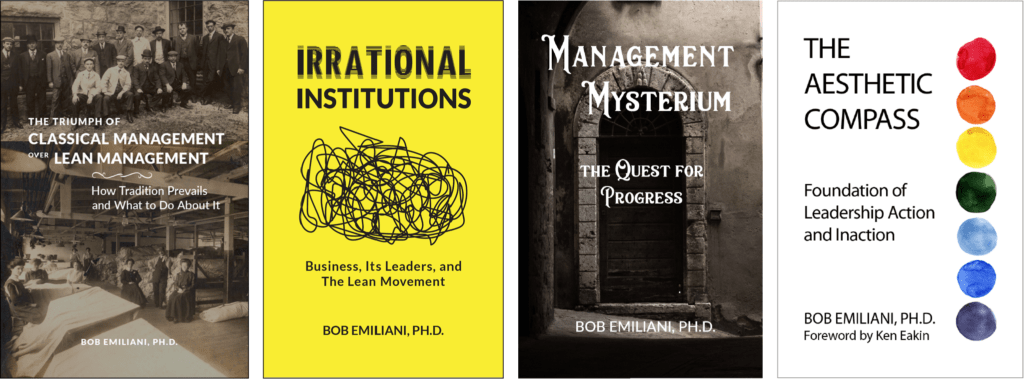
One of the things that Lean practitioners learn at the start is the importance of understanding processes so that better results will be consistently achieved. This intimate relationship between means and ends is obscure to most people, and so documenting and studying process is a big revelation. They learn to see causality: how waste, unevenness, and unreasonableness, and many other problems generate high costs, poor quality, long-lead-times, etc.
To Lean people, the concept of “process and results” is a welcome departure from the traditional focus on results and blaming people for problems. In the award-winning book Better Thinking, Better Results, Ed Miller (former Wiremold Vice President of marketing) stressed the importance of being focused on the process to produce good results (p. 214):
I tell my people that I very rarely care about the end result. I’m comfortable that we’ll get a good result if the process used to get there is right. If the process is good, it becomes more sustainable and repeatable… The most important thing is how you get there.
This was the view of the entire Wiremold senior management team, which in turn influenced all other managers and workers at Wiremold. Through better thinking (curiosity via kaizen) they created better processes that produced consistently better results. And good processes were continuously subject to experimentation to further improve results.
Yet, to leaders skilled in classical management, causality between process and results is an obviously flawed ideology, mistaken point of focus, and waste of resources (time, labor, and money). Business leaders who are only interested in results — those who demand results from self and others, no matter the process — are held in much higher esteem by society than the wimpy leaders who care about process more than results. The results-oriented boss is strong and honorable while the process-oriented boss is weak and indecisive.
Classical management leaders have a nearly immovable viewpoint that process and results are the inverse of each other — it is either-or, and one cannot have both. They believe that process becomes an end unto itself and that the only possible outcome is bad results and do-overs that produce more bad results. Attachment to process distracts people from achieving the required result, which is what matter most. Process is seen as a pursuit of perfection that disengages people from the daily fight to achieve results. It does not help that Lean principle #5, “pursue perfection” (Lean Thinking, p. 10) — “…continue it [the process] until a state of perfection is reached in which perfect value is created with no waste” — reinforces and legitimizes the dichotomy.
There is great peer-pressure among managers to conform to this dichotomy because process exposes causality, which leaders skilled in classical management will immediately find to be embarrassing. It will quickly show they are poor leaders, poor managers, and unaware of what is happening under their nose. These leaders see it as unwise to trust process for the simple reason that they do not trust people (workers). Perhaps most importantly, their standard remedy of blaming people for problems must not be subverted by allowing people to focus on process.
Lean people, not grasping the strength and value of the of the dichotomy to leaders, think all they need to do is explain the logic of “process and results” and show the boss examples of better processes that produce better results. The data, coupled with seeing the truth (the physical reality), will result in a new mindset for the leader which will produce a new result — an agreement that the focus should shift from results to process and results. As many of us have found out, this is not a winning argument. In proffering such arguments, two grave mistakes are made:
- It proves the leader wrong
- It challenges the leader’s right to think and do as they please
The first mistake will be met with smiles and nods, signals that mean neither agreement nor satisfaction. It is mere courtesy. The second mistake is worse than the first. It disrespects the intangible aspects of leadership gained through experience that they rely for decision-making: preconceptions, cognitive biases, expediency, blaming people for problems, etc. Process and results, and Lean more generally, is an insult to leaders’ worldview wherein decades of professional and business success have been achieved by focusing on results.
It also does not help that organizations promoting Lean (e.g. Lean Enterprise Institute, Catalysis) have “faculty” which supports the common preconception of an academic organization doing academic work that has little bearing on leaders’ interests and the business results they seek to achieve. These pseudo-academic organizations intensify the dichotomy, rather than dissolve it, and thus inadvertently undermine and delegitimize themselves (in recent decades, higher education has also managed to do the same in similar and different ways). They are a sandbox for the devoted to play in.
To most leaders, the dichotomy is a source of personal pride and one that is worth perpetuating. It is a simplification of reality that is characteristic of classical management and which is held in high regard as a sign of superior status and intelligence. The dichotomy has both offensive and defensive value for beating back incursions into leaders’ prerogative.
All of this is to say that the Lean community still does not understand the current state of leadership — the mind of the CEO, classical management, the institution of leadership, and how it reproduces. The process-results dichotomy is just one example that highlights this lack of understanding. I encourage those who wish to learn more to read these four books:

